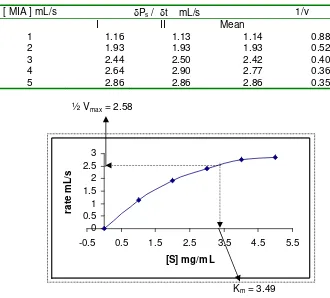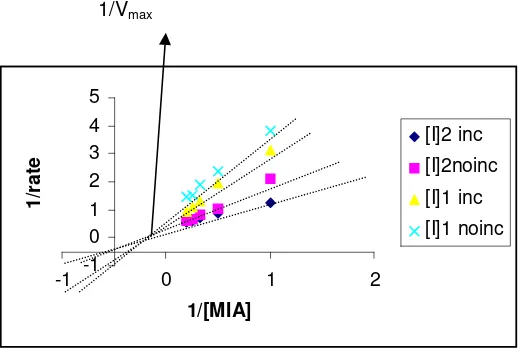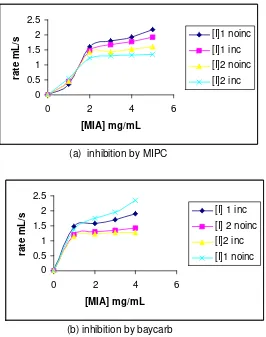KINETICS OF THE ACETYLCHOLINESTERASE (AchE) INHIBITION
HENDRY YANUAR
Chemistry Dept - FMIPA, Cenderawasih State University, Jayapura- Papua
ABSTRACT
Acetylcholinesterase (AchE) is an enzyme, which work on acetylcholine hydrolysis. Some insecticides can inhibit the activities of this enzyme. The purpose of this research was determined the kinetics of the AchE inhibition over the organophosphate and carbamat inhibitors with the methylindoxylacetate (MIA) as a substrate. The AchE extract was obtained from the local honeybee head (100 heads on the 5 mL of phosphate buffer 0.05 M). Based on the preliminary analysis, the volume of the enzyme extract for the reaction rate was 100 μL on 1-5 mL of the substrate. Monocrothopos, Carbophenathion, Baycarb and MIPC were used as inhibitors which the concentration were 0.0018, 0.0030, and 0.0042 mg/mL respectively. The reaction rate were measured by Fluorescence HPLC Monitor (Shimadzu RF 535) at 540 nm, and some computational program were used on data analysis. The result of this research showed that the maximum rate of MIA hydrolysis by AchE without the presence of inhibitor was 5.16 mL/s and the hydrolysis constant (Km) was 3.49, and the inhibitors did not influence the maximum rate of substrate hydrolysis. It was finally concluded that the kinetics of AchE inhibition on MIA hydrolysis over the organophosphate and carbamat inhibitors was the competitive inhibition.
Keyword: acetylcholinesterase, inhibition, organophosphate, carbamat
INTRODUCTION
Acetylcholinesterase (AchE) is an enzyme, which work on the acetylcholine hydrolysis to produce the acetic acid and choline. The reaction was written on scheme 1.
AchE has two kinds of active sites, that were anionic and estheratic sites. The anionic site (carboxylic acid from the glutamic or aspartate) has two negative charges and bonded to the nitrogen from the acetylcholine. The estheratic site was involved on the substrate hydrolysis and have the base (imidazole from the histidine) and acid groups (aromatic hydroxyl from the tyrosine). The imidazolin group was formed to activate the serine
hydroxyl, and then the partial negative charge of the serine oxygen will be increasing the nucleofilic attack to the carboxyl group of acetylcholine.
132
Indonesian Journal of Chemistry
The schematic diagram of enzyme carbamilation can be describe on scheme 2 [2]. Where: E = active enzyme, EI= reversible enzyme complex, E* = carbamilated enzyme (inactive)
The formation of EI complex was depending on the affinity of the inhibitor to the enzyme and dissociation constant.
[E] [I]
Ka= (1)
[EI]
The rate of irreversible inhibition was determined by phosporilation constant, k4. If
the enzyme was reversible activated to E* by the inhibitor (k5=0), the formation rate of
EI can be describe as follow:
δ[EI]/ δt = k3 [ E ] [ I ] – k –3 [ EI ] – k4 [ EI ]
The AchE extract was obtained from honeybee head, 100 heads on the 5 mL phosphate buffer 0.01M. The schematic diagram of enzyme extraction and substrate hydrolysis rate measurement were as follow.
(2) and
E* = δ[ E*] = k4 [ EI ] (3)
In this research the AchE enzyme was extracted from the local honeybee head (Local strain from Wamena Region-Papua Prov.), according to [3], that the AchE from the bee head has the lowest impurities than the others AchE sources. The objectives of this research are to observe the kinetics of AchE inhibition on MIA hydrolysis and to develop the techniques of enzyme kinetic experiment.
EXPERIMENTAL SECTION
AchE extraction
Extract enzyme Keep in 40C for overnight
Centrifuged 6500 rpm for 10 minutes
Determination of MIA hydrolysis rate supernatant
No inhibitors inhibitors
Buffer + E + S no incubation 2 minutes incubation
Flourecenes HPLC Buffer + S + I + E Buffer + E+ I + S
(Shimadzu RF 535)
RESULT AND DISCUSSION
1) MIA hydrolysis without the inhibitors The result of MIA hydrolysis without the organophosphate and carbamat inhibitors was given in Table 1. The Vmax
and Km were obtained from plot of reaction
rate vs. substrate concentration as given in figure 1.
Based on the powerfit program (order one) calculation, it was obtained that the value of Vmax was 5.16 and Km was
3.49, so the value of (1/Vmax) and (-1/Km)
were 1.94 and –0.29 respectively. The
value of Km that obtained from this graphic
was not represent the true value of Km.
Palmer (1985), reported that the value of Km that obtained from the graphic was quite
different with the value of Km that obtained
from the reaction rate determination. Figure 1, showed that the activities of AchE still in increased by substrate concentration increasing. The temperature increasing during enzyme extraction and crude enzyme centrifugation was caused the enzyme activity decreased. So that, in this research the activity of AchE was not optimal on MIA hydrolysis.
Table 1 the result of MIA hydrolysis without the inhibitors
[ MIA ] mL/s δPs / δt mL/s 1/v
I II Mean
1 1.16 1.13 1.14 0.88
2 1.93 1.93 1.93 0.52
3 2.44 2.50 2.42 0.40
4 2.64 2.90 2.77 0.36
5 2.86 2.86 2.86 0.35
½ Vmax = 2.58
0 0.5 1 1.5 2 2.5 3
-0.5 0.5 1.5 2.5 3.5 4.5 5.5
[S] mg/mL
rate mL/s
Km = 3.49
Figure 1 Plot of reaction rate vs substrate concentration
Table 2 The value of Vmax and Km of MIA hydrolysis by AchE over
organophosphate inhibitors
Organophosphate Vmax
1 2 3 4
Monocrothopos 4.73 4.04 4.73 5.51
Carbophenanthion 4.79 5.05 4.96 4.88
Km
Monocrothopos 11.14 16.67 28.01 51.55
Carbophenathion 8.76 19.88 17.86 45.45
134
Indonesian Journal of Chemistry
0 0.5 1 1.5 2
-0.5 1.5 3.5 5.5
[MIA] mg/mL
rate mL/s
[I] 1 no inc
[I} 2 no inc
[I] 2 inc [I] 1 inc
(a) inhibition by monocrotophos
0 0.5 1 1.5 2 2.5
-0.5 1.5 3.5 5.5
[MIA] mg/mL
rate mL/s
[I] 1 no inc
[I} 2 no inc
[I] 2 inc [I] 1 inc
(b) inhibition by carbophenanthion
Figure 2 Plot of reaction rate vs. substrate concentration in the presence of inhibitor
1/Vmax
-1 0 1 2 3 4 5
-1 0 1 2
1/[MIA]
1/rate
[I]2 inc [I]2noinc
[I]1 inc [I]1 noinc
2) MIA hydrolysis over organophosphate inhibitor
The organophosphate was used as inhibitors in this research were monocrothopos and carbophenanthion, which the concentration were 0.0018 and 0.003 mg/mL respectively. The results of MIA hydrolysis by AchE over organophosphate inhibitors was given in table 2. This experiment was divided into two conditions: no incubation of enzyme-substrate-inhibitor and 2 minutes incubation of enzyme-substrate inhibitor.
The statistical test of Vmax showed
that the value of Vmax was obtained from
this experiment was not different with the value of Vmax was obtained from the
experiment of MIA hydrolysis without the inhibitors, but the value of Km was changed.
It was showed that the increasing of inhibitors concentration was increased the value of Km. The value of Km that obtained
from the experiment with 2 minutes incubation was higher than the value of Km
that obtained from the experiment with no incubation. This phenomenon can be explain that during the incubation the bonding between the enzyme and the inhibitor was established, so its need of more time for breaking the bonding. This condition was caused the decreased of substrate rate hydrolysis, and the rate determining steps were the concentration and affinity of substrate to the AchE.
Plot of reaction rate vs. substrate concentration in the presence of inhibitor is shown in Figure 2. In order to know the type of enzyme inhibition, it is importance to observe the plot of (1/rate) vs. (1/substrate
concentration); the plot was given in figure 3. Figured 3 showed that the type of enzyme inhibition was competitive inhibition, it was proved by unchanged value of Vmax (the line was crossed at one point).
3) MIA hydrolysis over carbamat inhibitor
MIPC and baycarb were used as carbamat inhibitors in this research, which the concentration were 0.0042 and 0.0030 mg/mL respectively. The results of MIA hydrolysis over organophosphate inhibitors was given in table 3. This experiment was divided into two conditions: no incubation of enzyme-substrate and 2 minutes incubation of enzyme-substrate.
Figure 4 showed that the carbamat inhibitor has lower influence on the rate hydrolysis of MIA than the organophospate. It was proved by the rate of MIA hydrolysis of each condition was almost in the same value. This condition showed that the organophosphate has bigger affinity to the AchE than the carbamat. The value of Vmax
was obtained in this experiment was unchanged, the inhibitor just influence the value of Km. The changed value of Km will
observe by plot of (1/rate) vs. (1/substrate concentration).
Figure 5 showed that the type of enzyme inhibition by carbamat was competitive inhibition, it was proved by the unchanged value of Vmax and variable value
of Km.
Table 3 The value of Vmax and Km of MIA hydrolysis by AchE over carbamat inhibitors
Carbamat Vmax
1 2 3 4
MIPC 4.69 4.97 4.59 4.68
Baycarb 4.87 4.64 4.76 4.78
Km
MIPC 16.06 21.93 43.33 47.62
Baycarp 20.49 27.39 33.67 30.86
Note:1 [Inhibitor] = 0.0030 mg/mL, no incubation, 2 [Inhibitor] = 0.0030 mg/mL, 2 minutes incubation, 3 [Inhibitor] = 0.0042 mg/mL, no incubation, 4 [Inhibitor] = 0.0042 mg/mL, 2 minutes incubation,
136
Indonesian Journal of Chemistry
0
(b) inhibition by baycarb
Figure 4 Plot of reaction rate vs. substrate concentration in the presence of inhibitor
1/Vmax
Figure 5 Lineweaver-Burk Plot of carbamat inhibitor
CONCLUSION
It was concluded that the Vmax of MIA
hydrolysis by AchE without the presence of inhibitor was 5.16 mL/s and the value of Km
was 3.49. The inhibitor did not change the value of Vmax, but it was changed the value
of Km. The kinetic inhibition of MIA
hydrolysis by AchE over organophosphate and carbamat inhibitor was competitive
ACKNOWLEDGEMENT
REFERENCES
1. Falah, Iip Izul, 1994, Activation, Hydrolysis and Ezyme Inhibition Kinetics in Pre and Post Chromathographic Derivation of Organophosphate and Carbamat Pesticides”, Dessertation, GMU Yogyakarta.
2. Segel, I.H., 1975, ”Enzyme Kinetics”, John Wiley and Sons Inc., New York. 3. Rossenberry, T.L., Chang, H.W., and



